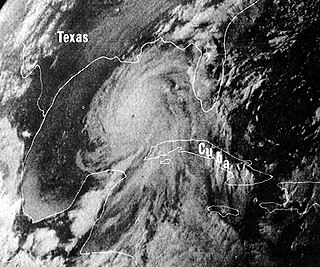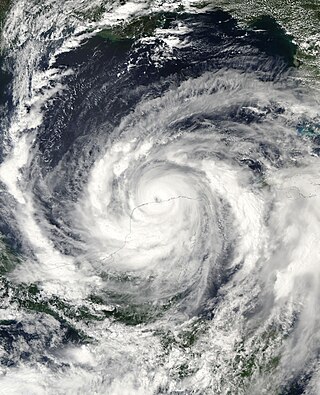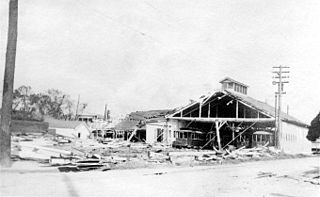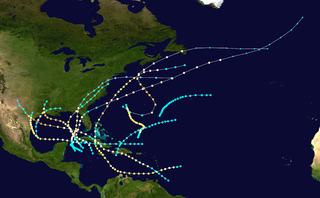
Hurricane Lili was the second costliest, deadliest, and strongest hurricane of the 2002 Atlantic hurricane season, only surpassed by Hurricane Isidore, which affected the same areas around a week before Lili. Lili was the twelfth named storm, fourth hurricane, and second major hurricane of the 2002 Atlantic hurricane season. The storm developed from a tropical disturbance in the open Atlantic on September 21. It continued westward, affecting the Lesser Antilles as a tropical storm, then entered the Caribbean. As it moved west, the storm dissipated while being affected by wind shear south of Cuba, and regenerated when the vertical wind shear weakened. It turned to the northwest and strengthened up to category 2 strength on October 1. Lili made two landfalls in western Cuba later that day, and then entered the Gulf of Mexico. The hurricane rapidly strengthened on October 2, reaching Category 4 strength that afternoon. It weakened rapidly thereafter, and hit Louisiana as a Category 1 hurricane on October 3. It moved inland and dissipated on October 6.

Hurricane Camille was a powerful, deadly and destructive Category 5 major hurricane which became the second most intense tropical cyclone on record to strike the United States and is one of just four Category 5 hurricanes to make landfall in the U.S.

The Great Hurricane of 1780 was the deadliest Atlantic hurricane on record, as well as the deadliest tropical cyclone in the Western Hemisphere. An estimated 22,000 people died throughout the Lesser Antilles when the storm passed through the islands from October 10 to October 16. Specifics on the hurricane's track and strength are unknown, as the official Atlantic hurricane database only goes back to 1851.

Hurricane Isidore was a powerful tropical cyclone that caused widespread flooding and heavy damage across Mexico, Cuba, and the United States in September 2002. The ninth named storm and the second hurricane in the 2002 Atlantic hurricane season, and the fifth of eight named storms to occur in September of that year, Isidore peaked as a Category 3 hurricane, causing damage, as well as four fatalities in Jamaica, Cuba, Mexico, and the United States. Isidore is also noted for threatening to strike the northern Gulf Coast as a Category 4 hurricane, however, the storm struck the region as a moderately-strong tropical storm, due to a track change that brought the storm over the Yucatán Peninsula for over a day, which significantly weakened the cyclone in the process. The primary impact from the storm was the heavy rainfall, which fell across southeast Mexico, and also from the central United States Gulf coast into the Ohio Valley.

Hurricane Ivan was a large, long-lived, Cape Verde hurricane that caused widespread damage in the Caribbean and United States. The cyclone was the ninth named storm, the sixth hurricane and the fourth major hurricane of the active 2004 Atlantic hurricane season.

The 1900 Atlantic hurricane season featured the Galveston hurricane, the deadliest natural disaster in the history of the United States. A total of 10 tropical cyclones formed, seven of which intensified into a tropical storm. Three of those made landfall in the United States. The first system was initially observed over the central Atlantic Ocean on January 17, while the final storm transitioned into an extratropical cyclone on October 28. These dates fall within the period with the most tropical cyclone activity in the Atlantic. Every storm of the season except the seventh system existed simultaneously with another tropical cyclone.

The 1898 Atlantic hurricane season marked the beginning of the Weather Bureau operating a network of observation posts across the Caribbean Sea to track tropical cyclones, established primarily due to the onset of the Spanish–American War. A total of eleven tropical storms formed, five of which intensified into a hurricane, according to HURDAT, the National Hurricane Center's official database. Further, one cyclone strengthened into a major hurricane. However, in the absence of modern satellite and other remote-sensing technologies, only storms that affected populated land areas or encountered ships at sea were recorded, so the actual total could be higher. An undercount bias of zero to six tropical cyclones per year between 1851 and 1885 and zero to four per year between 1886 and 1910 has been estimated. The first system was initially observed on August 2 near West End in the Bahamas, while the eleventh and final storm dissipated on November 4 over the Mexican state of Veracruz.
The decade of the 1830s featured the 1830s Atlantic hurricane seasons. While data is not available for every storm that occurred, some parts of the coastline were populated enough to give data of hurricane occurrences. Each season was an ongoing event in the annual cycle of tropical cyclone formation in the Atlantic basin. Most tropical cyclone formation occurs between June 1 and November 30.
The decade of the 1810s featured the 1810s Atlantic hurricane seasons. While data is not available for every storm that occurred, some parts of the coastline were populated enough to give data of hurricane occurrences. Each season was an ongoing event in the annual cycle of tropical cyclone formation in the Atlantic basin. Most tropical cyclone formation occurs between June 1 and November 30.

The New Orleans Hurricane of 1915 was an intense Category 4 hurricane that made landfall near Grand Isle, Louisiana, and the most intense tropical cyclone during the 1915 Atlantic hurricane season. The storm formed in late September when it moved westward and peaked in intensity of 145 mph (233 km/h) to weaken slightly by time of landfall on September 29 with recorded wind speeds of 126 mph (203 km/h) as a strong category 3 Hurricane. The hurricane killed 275 people and caused $13 million in damage.
The 1780 Atlantic hurricane season ran through the summer and fall in 1780. The 1780 season was extraordinarily destructive, and was the deadliest Atlantic hurricane season in recorded history, with over 28,000 deaths. Four different hurricanes, one in June and three in October, caused at least 1,000 deaths each; this event has never been repeated, and only in the 1893 and 2005 seasons were there two such hurricanes. The season also had the deadliest Atlantic hurricane of all time, the Great Hurricane of 1780. Only one of the known storms was not a hurricane.

The 1886 Atlantic hurricane season ran through the early summer and the first half of fall in 1886. This is the period of each year when most tropical cyclones form in the Atlantic basin. It was a very active year, with ten hurricanes, six of which struck the United States, an event that would not occur again until 1985 and 2020. Four hurricanes became major hurricanes. However, in the absence of modern satellites and other remote-sensing technologies, only storms that affected populated land areas or encountered ships at sea are known, so the actual total could be higher. An undercount bias of zero to six tropical cyclones per year between 1851 and 1885 and zero to four per year between 1886 and 1910 has been estimated. Of the known 1886 cyclones, Hurricane Seven and Tropical Storm Eleven were first documented in 1996 by Jose Fernandez-Partagas and Henry Diaz. They also proposed large alterations to the known tracks of several other 1886 storms.

The 1917 Nueva Gerona hurricane was the most intense tropical cyclone to strike the Florida Panhandle until Hurricane Opal in 1995. The eighth tropical cyclone and fourth tropical storm of the season, this system was identified as a tropical storm east of the Lesser Antilles on September 20. After crossing the Lesser Antilles, the system entered the Caribbean Sea and achieved hurricane intensity on September 21. After becoming a Category 2 hurricane, the storm struck the northern coast of Jamaica on September 23. Early on September 25, the cyclone reached Category 4 status and attained maximum sustained winds of 150 mph (240 km/h) soon thereafter. Later that day, the hurricane made landfall in eastern Pinar del Río Province, Cuba. The system entered the Gulf of Mexico shortly thereafter and weakened slightly. Recurving to the northeast, the hurricane briefly threatened Louisiana before turning toward Florida. Early on September 29, the hurricane made landfall near Fort Walton Beach, Florida, with winds of 115 mph (185 km/h). Once over land, the cyclone rapidly weakened and transitioned into an extratropical cyclone before dissipating on September 30.

The 1879 Atlantic hurricane season ran from the summer to near the end of autumn in 1879. In 1879 there were two tropical storms, four hurricanes, and two major hurricanes. However, in the absence of modern satellite and other remote-sensing technologies, only storms that affected populated land areas or encountered ships at sea were recorded, so the actual total could be higher. An undercount bias of zero to six tropical cyclones per year between 1851 and 1885 and zero to four per year between 1886 and 1910 has been estimated. Of the known 1879 cyclones, Hurricane One were first documented in 1995 by Jose Fernandez-Partagas and Henry Diaz. They also proposed large changes to the known tracks of Hurricanes Two, Three, Seven and Eight. Later one storm was deemed not to be a tropical cyclone at all and was dropped from the database.

The 1909 Grand Isle hurricane was a large and deadly Category 3 hurricane that caused severe damage and killed more than 400 people throughout Cuba and the northern coast of the Gulf of Mexico. Forming out of a tropical disturbance just south of Hispaniola on September 13, 1909, the initial depression slowly intensified as it moved west-northwest towards Jamaica. Two days later, the system attained tropical storm intensity and turned northwestward towards Cuba. On September 16, it attained the equivalent of a modern-day Category 1 hurricane on the Saffir–Simpson hurricane scale and further strengthened to attain winds of 100 mph (160 km/h) before making landfall in Pinar del Río Province, Cuba on September 18. After a briefly weakening over land, the system regained strength over the Gulf of Mexico, with peak winds reaching 120 mph (195 km/h) the following day. After only slightly weakening, the hurricane increased in forward motion and made landfall near Grand Isle, Louisiana on September 21. The system quickly lost strength after moving over land, dissipating the following day over Missouri.

The 1906 Mississippi hurricane was a deadly and destructive hurricane during the 1906 Atlantic hurricane season. The fourth hurricane of the season, the system was originally observed in the western Caribbean on September 22; however, modern research revealed that the system became a tropical depression on September 19. The system slowly intensified, eventually becoming a major hurricane by September 24. The system made landfall near Pascagoula, Mississippi, during the evening of September 27, devastating the cities of Pensacola and Mobile and the state of Mississippi. Damage totaled to at least $19,221,000, and more than 134 people were killed.

The 1855 Atlantic hurricane season featured tropical cyclone landfalls in the Gulf Coast of the United States, the Greater Antilles, and Mexico, but none along the East Coast of the United States. It was inactive, with only five known tropical cyclones. Another tropical storm was believed to have existed offshore Atlantic Canada in late August and early September, but HURDAT – the official Atlantic hurricane database – now excludes this system. The first known system was initially observed on August 5, while the final known storm was last noted on September 17. These dates fall within the period with the most tropical cyclone activity in the Atlantic. At one point during the season, two tropical cyclones existed simultaneously. Two of the cyclones only have a single known point in their tracks due to a sparsity of data.

The 1856 Atlantic hurricane season featured six tropical cyclones, five of which made landfall. The first system, Hurricane One, was first observed in the Gulf of Mexico on August 9. The final storm, Hurricane Six, was last observed on September 22. These dates fall within the period with the most tropical cyclone activity in the Atlantic. Only two tropical cyclones during the season existed simultaneously. One of the cyclones has only a single known point in its track due to a sparsity of data. Operationally, another tropical cyclone was believed to have existed in the Wilmington, North Carolina area in September, but HURDAT – the official Atlantic hurricane database – excludes this system. Another tropical cyclone that existed over the Northeastern United States in mid-August was later added to HURDAT.

The 1875 Indianola hurricane brought a devastating and deadly storm surge to the coast of Texas. The third known system of the 1875 Atlantic hurricane season, the storm was first considered a tropical cyclone while located east of the Lesser Antilles on September 8. After passing through the Windward Islands and entering the Caribbean Sea, the cyclone gradually began to move more northwestward and brushed the Tiburon Peninsula of Haiti late on September 12. On the following day, the storm made a few landfalls on the southern coast of Cuba before moving inland over Sancti Spíritus Province. The system emerged into the Gulf of Mexico near Havana and briefly weakened to a tropical storm. Thereafter, the storm slowly re-intensified and gradually turned westward. On September 16, the hurricane peaked as a Category 3 hurricane with winds of 115 mph (185 km/h). Later that day, the hurricane made landfall near Indianola, Texas. The storm quickly weakened and turned northeastward, before dissipating over Mississippi on September 18.















